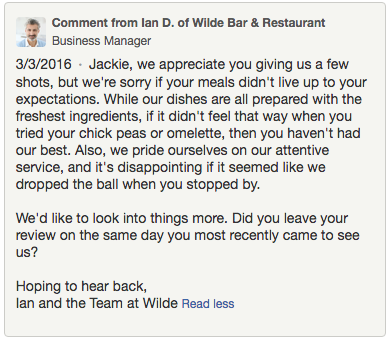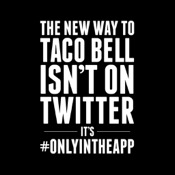
Do you remember the last time you visited a fast food drive through? Chances are, the employee who handed you a bag of food also asked you to fill out a survey.
Did you fill out the survey?
Probably not.
If you did, good on you. That restaurant’s employee is likely very appreciative.
Fast food employees already have a hard job, and asking their busy customers to fill out a survey is a tough sell.
If you’ve ever asked your own customers to leave you an online review, you know their struggle.
There’s a myth that only angry customers leave reviews for restaurants, and it definitely might seem that way. But statistics from Yelp reveal that two-thirds of all Yelp reviews are positive.
Positivity aside, it’s still hard to get positive reviews, and your potential customers encounter negative reviews every time they look for a new restaurant.
So, how do you protect your online reputation? And just how many people are actually looking at online reviews?
Online Reviews Matter
Consumers love reviews.
You can control your own website’s content and what you broadcast on social media, but you can’t control what your customers post on third party review sites like Yelp, TripAdvisor, Google, and UrbanSpoon/Zomato.
Those reviews are a huge part of your online reputation.
Here are some quick stats:
- 92% of consumers read online reviews for local, brick and mortar businesses – BrightLocal
- 87% of consumers won’t consider giving money to a business with a one or two star rating – BrightLocal
- 80% of consumers trust online reviews as much as they trust personal recommendations – BrightLocal
- 94% of consumers would consider buying from a business with a four star rating – BrightLocal
- 68% of millennials trust online reviews, as opposed to the 34% who trust television advertising – CrowdTap
- Consumers are more likely to trust a business with a rating between 4.2 and 4.5 stars than a business with a perfect five star rating – Spiegel Research
- 54% of consumers read online reviews before buying from a local business – Our own research at ReviewJump
There’s more to your online reputation than just your online reviews, but they’re compelling for your prospective customers.
When people are looking for a new restaurant, they use Google search. Google displays your reviews right on the search engine results page. Not only does it show its own Google reviews, but it’s likely to show results from Yelp and TripAdvisor, too, at the very least.
For restaurants, reviews are serious business. When I analyzed more than 20,000 Google local listings recently, I looked at 29 business types.
Restaurants were the most reviewed business type, by a long shot.
So, people are leaving reviews for restaurants. You already know that. The trick is getting genuine reviews from your real customers, and selling them on leaving a review can be difficult.
Even if you have no reviews now– sooner or later, your restaurant is going to get a review. And it might not be from your best customer.
Monitoring Your Restaurant’s Reputation (and Responding)
You can’t please every customer.
No matter how friendly your servers are, and no matter how good your food is, someone’s going to walk away unhappy. And they’re going to leave a review.
Unfortunately, other people might see that negative review before they see your charming website copy, your thoughtful, community-oriented blog, or your engaging social media presence.
So, what can you do?
Monitor and respond.
Find someone on your staff to check Yelp, TripAdvisor, UrbanSpoon, Google, and Facebook for new reviews at least three times a week. Once per day is best, but that’s an unrealistic time commitment for a busy restaurant.
Next, respond to every review. Positive and negative.
I can’t overstate the importance of this one enough.
When you respond to a positive review, it shows your customers you care about them even after they’ve left your restaurant. It makes a connection, and it makes them feel appreciated.
Responding to negative reviews, on the other hand, allows you to tell your side of the story in a public forum you otherwise have no control over– a page dedicated to your restaurant that you don’t own.
Responding to positive reviews:
- Respond promptly
- If you can, mention something you remember about the customer, but never give out any personal details; instead, just try to show them you remember them
- Give a genuine “thank you”
- Don’t just copy and paste responses, as they all show up in public, and other potential customers will notice the repetition
- Say you’re looking forward to seeing them again
Here’s a great example:

When you respond to positive reviews, it shows other, potential customers that you care about everyone who enters your restaurant, and that you appreciate it when people leave you a nice review.
Customers, especially in this age of social media, love to feel included and valued. When you respond to their positive reviews, you’re putting them in the spotlight– and you’re letting potential customers know you’re willing to put them in the spotlight, too.
Negative reviews are a bit tricker, of course.
That’s because they’re always frustrating, and sometimes infuriating. They often seem like a direct attack upon your business, your employees, your skill level, your dedication, and even your life’s work.
Usually, these reviews just come from hard-to-please customers.
When you spot a pattern of recurring issues in your online reviews, though, it’s time to look inward. When one disgruntled customer mentions bad service, they were probably having a bad night. When five customers mention bad service? You might have a problem employee, or you might be working your servers too hard.
How to Respond to Negative Reviews
Here’s some sound advice for responding to negative reviews:
- Take time to cool off if you’re offended, but respond within 24 hours
- Always be professional– never insult anyone, use foul language, or engage in name calling
- Respond to the review in private first– most review sites allow you to contact the customer
- In your private reply, take ownership of the problem and address their concerns, and see how you can make it right
- At the same time, present the facts and your side of the story– don’t act defensive or be condescending, just show them the facts
- Invite them back
- Respond in public, whether they withdraw/update the review or not
- Your public response is your chance to show everyone else your side of the story– present the facts, be honest, be professional, and be direct
Here’s a great example of how to respond to a negative review:

Ian took ownership of the problem, apologized, and said he’d like to look into the incident more. He ended the reply with a question, which invites further discourse.
It shows potential customers how much he cares.
As a side note, you can also show how much you care on social media and in various comments sections, both on your site and off site.
Always monitor your social media channels, your blog, or anywhere else you’re being mentioned. Set up a Google Alert for your restaurant’s name, if need be.
Reply in a quick, friendly, and professional manner. In a recent survey I conducted, I found 46% of consumers expect a response within 6 hours of reaching out to a business on social media.
Be as quick as you can.
Asking for Reviews
When it comes to positive reviews, you oftentimes have to ask.
Even your happiest customers might not leave a review unless they’re prompted.
Unfortunately, there’s no “magic bullet” solution for this when you’re just asking and making a request. It has to come off as genuine, but it differs for every person.
For now, here’s some quick advice:
- Don’t have a dedicated “review station” or computer in your restaurant– Google, Yelp, and TripAdvisor will know if all your reviews come from the same IP address, and those good reviews will be filtered
- Don’t offer money, free food, or other incentives in exchange for reviews, as that violates most review sites’ terms of service
- Explain how reviews help your restaurant, and express that the customer would be doing you a huge favor; also express appreciation for their time
- Never be pushy
If you ask often enough, you’ll find a groove and more reviews will start coming in. It can be tricky, but it’s worth it.
Positive > Negative
I touched on this briefly before, but your online reputation isn’t only about your reviews.
Reviews are huge, but there’s more to the story.
Your potential customers are researching you through third party review sites, social media, and your own website.
Strive for positivity in your own content.
Don’t bad-mouth competitors, the industry, people with certain food allergies, or your own customers.
Potential customers will see anything negative you put out there. And it will influence their eating decision.
I’m not saying to not let your personality shine through in your content– you absolutely should. You can also talk about frustrations you share with your customers (overdone steaks, people badmouthing vegan food, etc.), but never name name or insult anyone.
Writing negative things about other restaurants or specific people will damage your reputation.
Positivity breeds positivity, especially in a volatile place like the internet.
Customer Delight
One more quick note before I sign off.
Your online reputation, at the end of the day, is all about delighting your customers.
For my money, no one’s more invested in customer delight than restaurant owners and their employees. You already eat, breathe, and sleep customer delight.
But delighting your customers has to be every employee’s goal. Bartenders, dishwashers, bussers, servers, and your marketing team all have to be in on it.
Most service industry people excel at this. No matter how crappy a server feels, she’ll put in the extra effort to delight even the grumpiest customer. But all her efforts go to waste if every employee isn’t on board.
I’m sure you already know this.
But delighting the customer doesn’t stop once they leave the restaurant. It’s about building a relationship so they visit you again and again.
Responding to reviews and social media posts is a big part of this. Giving little callouts to your favorite customers on your own website and social media profiles fits into customer delight, as well.
Your online presence should be both a showcase for your food and service, and a love letter to your customers.
Make them feel valued, even when they’re not sitting at one of your tables.
At the end of the day, protecting your reputation is all about being attentive and vigilant. It means monitoring social media and review sites, responding to your customers, and making them feel appreciated.
Your potential customers are researching you online as we speak. What do you want them to see?
It’s up to you.





